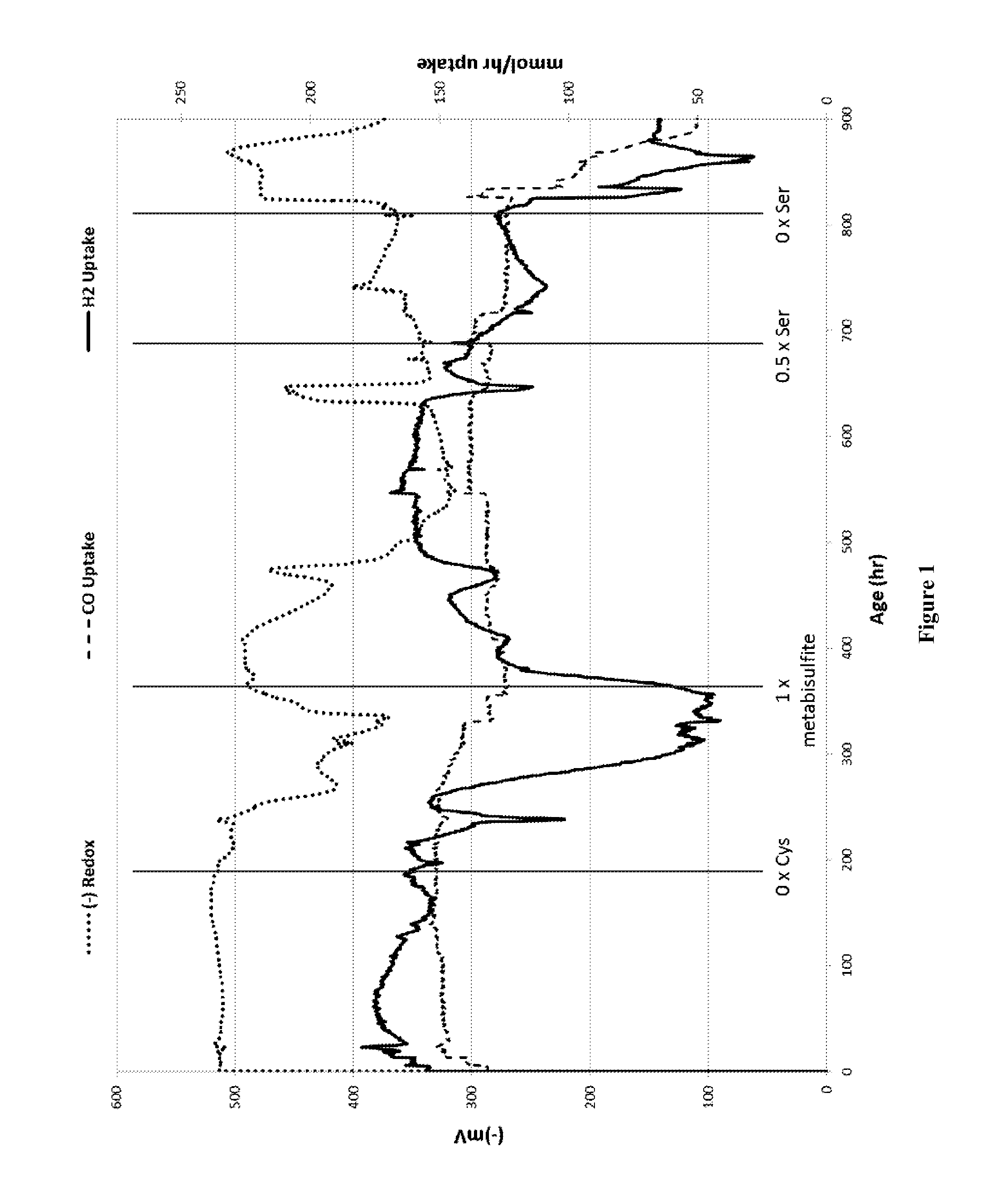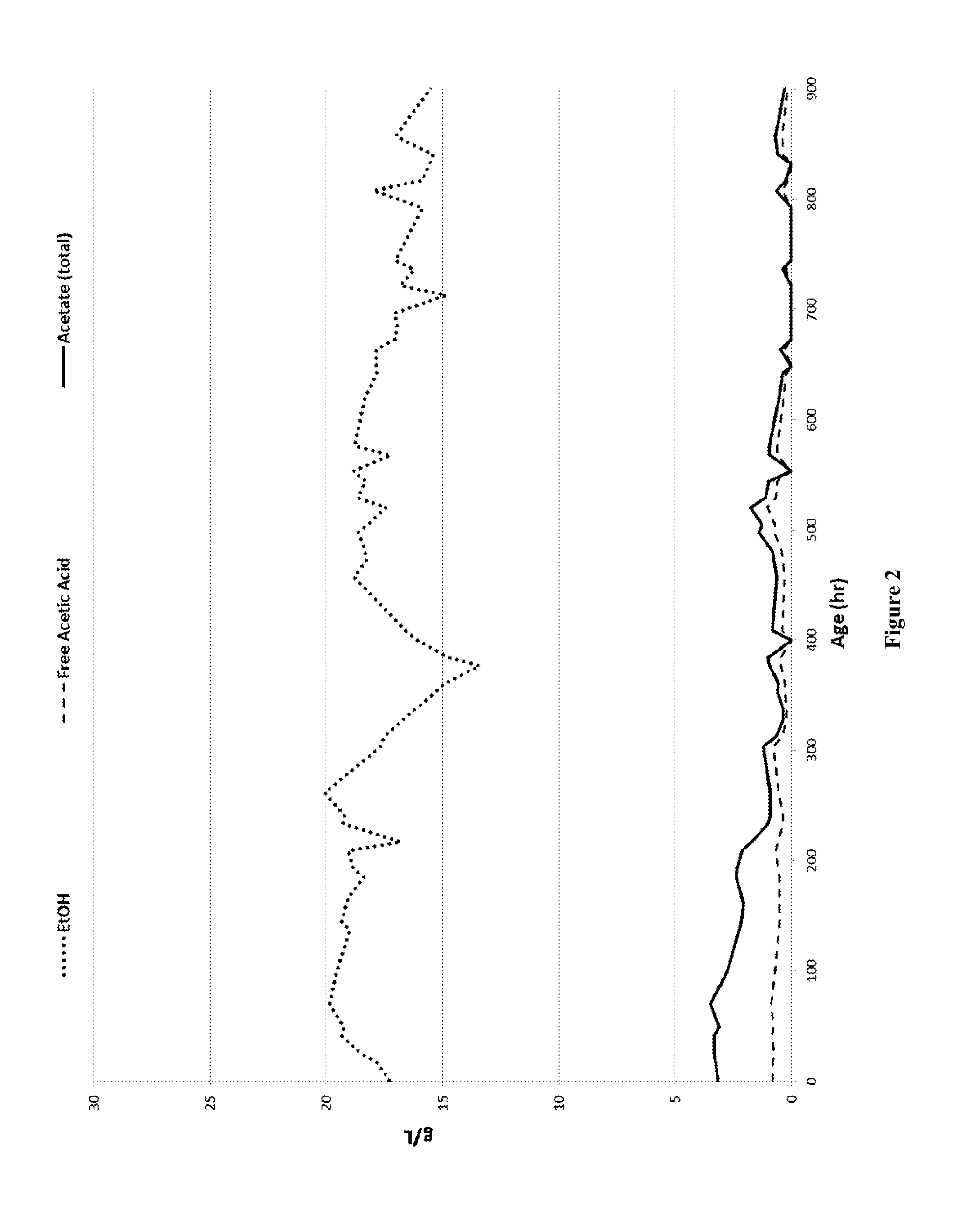Method for producing C2 oxygenates by fermentation using high oxidation state sulfur
a technology of oxidation state sulfur and oxygenate, which is applied in the direction of fermentation, biofuels, etc., can solve the problems of reducing the selectivity of the process for more desired ethanol products, affecting the growth and viability of microorganisms, and affecting the production of ethanol, so as to achieve the effect of reducing the concentration of cysteine in the fermentation medium and reducing the concentration of organic sulfur in the fermentation medium over tim
- Summary
- Abstract
- Description
- Claims
- Application Information
AI Technical Summary
Benefits of technology
Problems solved by technology
Method used
Image
Examples
example 1
[0097]A seed culture comprising Clostridium coskatii obtained from cryogenic stocks of the microorganism on deposit as ATCC No. PTA-10522 and described in U.S. Pat. No. 8,143,037 as described in US Patent was grown in a seed vessel and then introduced into the fermentor at the beginning of the continuous fermentation run according to the General Procedures as previously described herein. At the initiation of the run (hour 0) the base liquid media entering the fermenter contained cysteine at a concentration of 0.6 mM which provided cysteine in an amount equal to about 0.5× the typical base reference concentration for the molar addition of cysteine as the sole sulfur source to the fermenter. In addition, 1.2 mM of metabisulfite (average 0.2 mM / day / OD) was added to the liquid media to provide a 2× addition of sulfur atoms along with 1.2 mM of serine to provide 1× addition of an amino acid constituent. DTPA was used as a chelant in this run at a concentration of 0.79 g / L. Throughout the...
example 2
[0100]A seed culture comprising Clostridium coskatii obtained from the same cryostock as described in Example 1 was introduced into the fermentor at the beginning of the continuous fermentation run. At the initiation of the run the liquid media entering the fermenter contained cysteine at a concentration of 0.96 mM which provided a 0.8× normalized molar addition of sulfur to the fermenter (˜0.064 mM / day / OD). Gas flow to the run started at about 100 ml / min, was increased step wise until reaching a value of about 200 ml / min at about hour 200 and remained at about 190 to 200 ml / min for the rest of the run. The gas had a volume percent composition of 34% CO, 10% CO2, 43% H2 and 12% CH4.
[0101]Base liquid media addition was varied within a range of about 1.7 to 2.9 liters per day. DTPA was used as a chelant in this run at a concentration of 0.79 g / L. Pressure throughout the run was maintained at 910 mbar and temperature throughout the run remained at approximately 37° C. The pH of the fer...
example 3
[0103]A new run was established by carrying over a batch of the culture from the end of the run described in Example 2 and initiating a new run for this example. At the initiation of this run (hour 0) the base liquid media entering the fermenter contained cysteine at a concentration of 0.6 mM (˜0.03 mM / day / OD) which provided 0.5× the typical base reference concentration for the standard molar addition of cysteine. In addition, 2.4 mM of metabisulfite was added to the liquid media at the initiation of the run to provide a 4× addition of sulfur atoms. Also at the initiation of the run L-methionine was added to the base liquid media at a concentration of 0.30 mM to provide a 0.25× addition of a sulfur bearing amino acid and serine was added to the base media at an average concentration of 1.2 mM (˜0.066 mM / day / OD) to provide a 1× addition of non-sulfur bearing amino acid. Diethylenetriaminepentaacetic acid A chelant of DTPA was used in this run at concentration of 0.079 g / L. Addition o...
PUM
| Property | Measurement | Unit |
|---|---|---|
| molar ratio | aaaaa | aaaaa |
| volume | aaaaa | aaaaa |
| volume | aaaaa | aaaaa |
Abstract
Description
Claims
Application Information
 Login to View More
Login to View More - R&D
- Intellectual Property
- Life Sciences
- Materials
- Tech Scout
- Unparalleled Data Quality
- Higher Quality Content
- 60% Fewer Hallucinations
Browse by: Latest US Patents, China's latest patents, Technical Efficacy Thesaurus, Application Domain, Technology Topic, Popular Technical Reports.
© 2025 PatSnap. All rights reserved.Legal|Privacy policy|Modern Slavery Act Transparency Statement|Sitemap|About US| Contact US: help@patsnap.com



